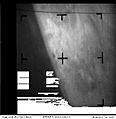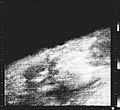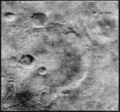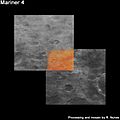Mariner 4 facts for kids
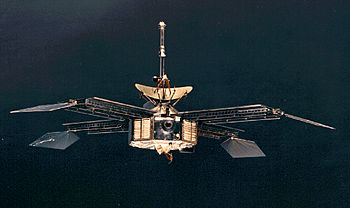
The Mariner 4 spacecraft
|
|
| Mission type | Mars flyby |
|---|---|
| Operator | NASA / JPL |
| Mission duration | 3 years, 23 days |
| Spacecraft properties | |
| Manufacturer | Jet Propulsion Laboratory |
| Launch mass | 260.8 kilograms (575 lb) |
| Power | 310 watts (at Mars encounter) |
| Start of mission | |
| Launch date | November 28, 1964, 14:22:01 UTC |
| Rocket | Atlas LV-3 Agena-D |
| Launch site | Cape Canaveral LC-12 |
| End of mission | |
| Last contact | December 21, 1967 |
| Orbital parameters | |
| Reference system | Heliocentric |
| Semi-major axis | 199,591,220 kilometers (124,020,230 mi) |
| Eccentricity | 0.17024754 |
| Perihelion | 165,611,300 kilometers (102,906,100 mi) |
| Aphelion | 233,571,130 kilometers (145,134,370 mi) |
| Inclination | 2.51 degrees |
| Period | 562.888 days |
| Flyby of Mars | |
| Closest approach | July 15, 1965, 01:00:57 UTC |
| Distance | 9,846 kilometers (6,118 miles) |
Mariner 4 was a robotic spacecraft sent by NASA to explore Mars. It was the fourth mission in the Mariner program. Its main goal was to fly past Mars and gather information. This mission was a huge success. It became the first spacecraft to successfully reach Mars.
Mariner 4 launched on November 28, 1964, from Cape Canaveral Air Force Station. After an eight-month trip, it finally reached Mars. The spacecraft made history by taking the first close-up photographs of another planet. It also carried other tools to study the atmosphere of Mars. The total cost for the Mariner 4 mission was about $83.2 million.
Contents
Journey to Mars
Mariner 4 began its long journey to Mars on November 28, 1964. It was launched using an Atlas-Agena rocket. The spacecraft traveled for about 228 days, covering millions of miles. This long trip showed how difficult it was to send probes across the solar system.
Reaching the Red Planet
On July 15, 1965, Mariner 4 successfully flew past Mars. It came within 9,846 kilometers (6,118 miles) of the planet's surface. This close approach allowed it to collect valuable data. It also took the first-ever close-up pictures of Mars.
Discoveries and Findings
Mariner 4 sent back 21 pictures of Mars. These images showed a surface covered in craters, much like Earth's Moon. This was a big surprise to scientists. Many had expected to see canals or other features. The pictures changed how we thought about Mars.
Martian Atmosphere
The spacecraft also studied the atmosphere of Mars. It found that the atmosphere was much thinner than expected. It was mostly made of carbon dioxide. This discovery meant that liquid water was unlikely to exist on the surface. This made the idea of life on Mars seem less likely at the time.
Magnetic Field Search
Mariner 4 carried a special tool called a magnetometer. This tool looked for a magnetic field around Mars. The spacecraft found no strong magnetic field. This was another important discovery about the planet.
End of the Mission
Mariner 4 continued to send back data for a long time after its Mars flyby. It kept working until December 21, 1967. By then, it had traveled far past Mars. The mission ended when contact was lost. This was likely due to damage from tiny space particles. Mariner 4 taught us a lot about Mars. It paved the way for future missions.
Images for kids
-
Jack N. James (center), JPL's Mariner 4 Project Manager, with a group in the White House presenting the spacecraft's famous picture Number 11 of Mars to US President Lyndon B. Johnson (center right) in July 1965.
See also
 In Spanish: Mariner 4 para niños
In Spanish: Mariner 4 para niños








